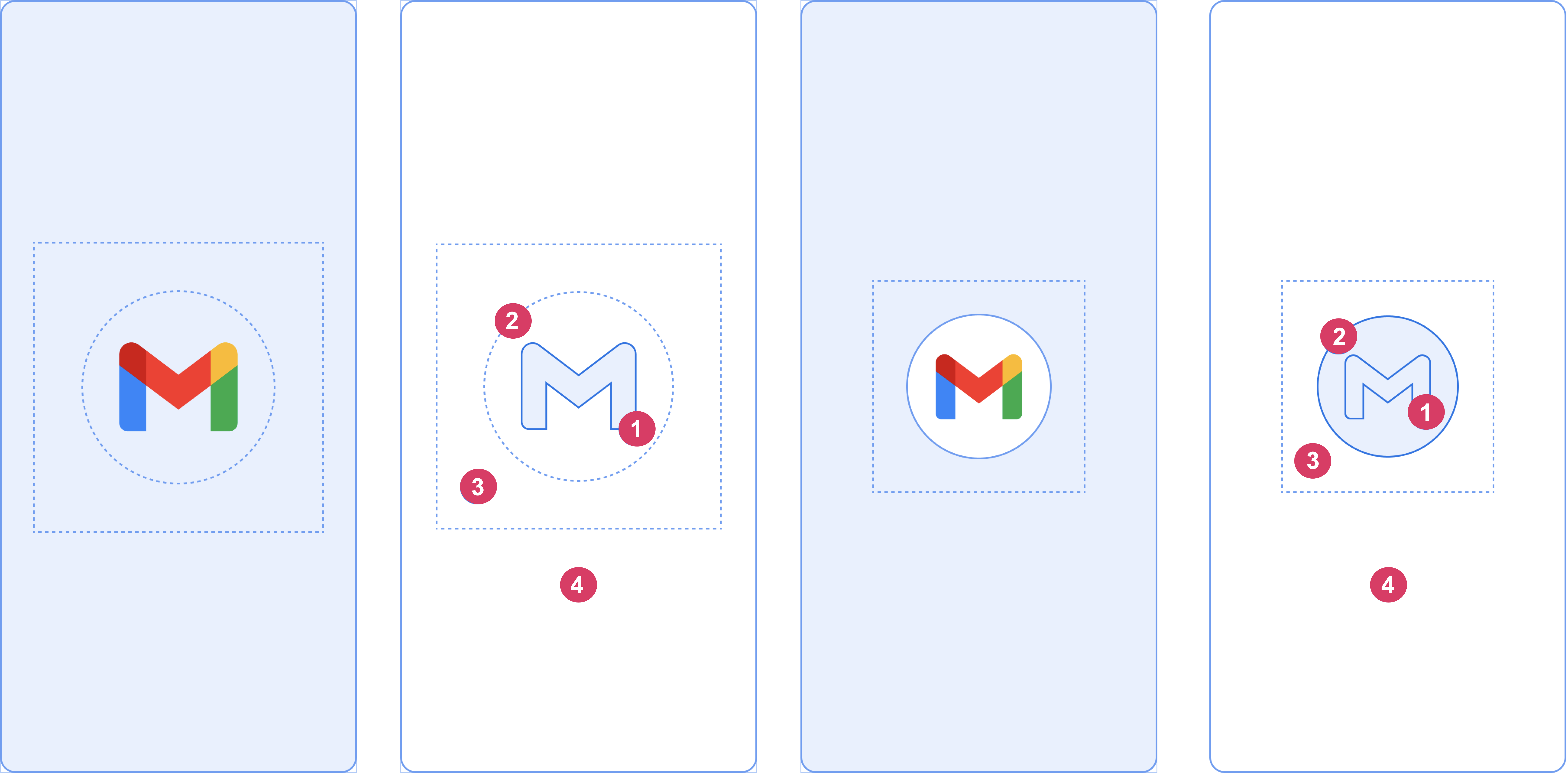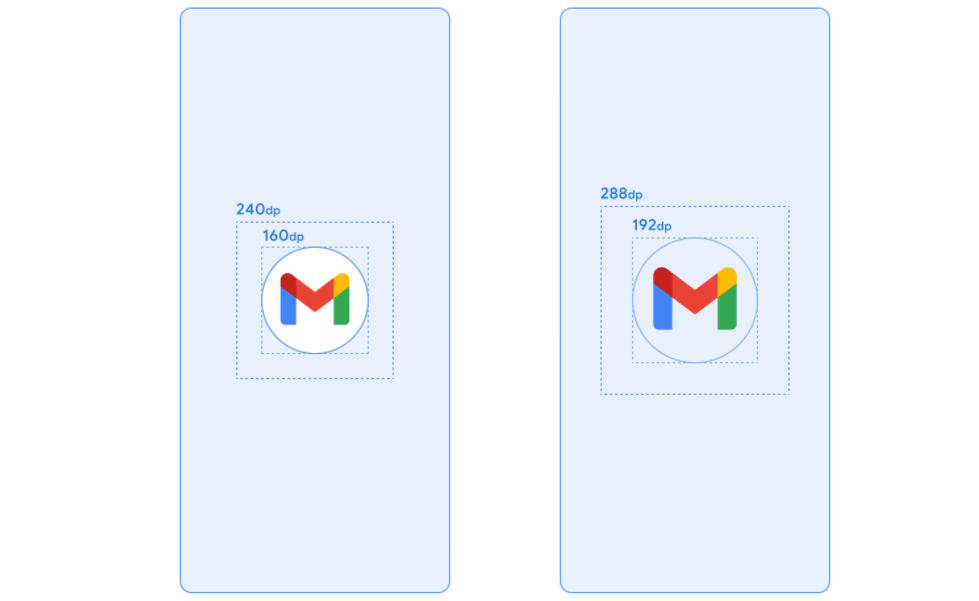Starting in Android 12, the
SplashScreen API lets apps launch
with animation, including an into-app motion at launch, a splash screen showing
your app icon, and a transition to your app itself. A SplashScreen is a
Window and
therefore covers an
Activity.
The splash screen experience brings standard design elements to every app launch, but it's also customizable so your app can maintain its unique branding.
In addition to using the SplashScreen platform API, you can also use the
SplashScreen
compat library, which wraps the SplashScreen API.
How the splash screen works
When a user launches an app while the app's process isn't running (a cold
start) or the Activity isn't
created (a warm start), the
following events occur:
The system shows the splash screen using themes and any animations that you define.
When the app is ready, the splash screen is dismissed and the app displays.
The splash screen never shows during a hot start.
Elements and mechanics of the splash screen
The elements of the splash screen are defined by XML resource files in the Android manifest file. There are light and dark mode versions for each element.
The customizable elements of a splash screen consist of the app icon, icon background, and window background:

Consider the following elements, shown in figure 2:
1 The app icon must be a vector drawable. It can be static or animated. Although animations can have an unlimited duration, we recommend not exceeding 1,000 milliseconds. The launcher icon is the default.
2 The icon background is optional and useful if you need more contrast between the icon and the window background. If you use an adaptive icon, its background is displayed if there is enough contrast with the window background.
3 As with adaptive icons, one-third of the foreground is masked.
4 The window background consists of a single opaque color. If the window background is set and is a plain color, it is used by default if the attribute isn't set.
Splash screen dimensions
The splash screen icon uses the same specifications as adaptive icons, as follows:
- Branded image: this must be 200×80 dp.
- App icon with an icon background: this must be 240×240 dp and fit within a circle 160 dp in diameter.
- App icon without an icon background: this must be 288×288 dp and fit within a circle 192 dp in diameter.
For example, if the full size of an image is 300×300 dp, the icon needs to fit within a circle with a diameter of 200 dp. Everything outside the circle turns invisible (masked).

Splash screen animations and the launch sequence
Additional latency is often associated with launching an app on a cold start. Adding an animated icon to your splash screen has obvious aesthetic appeal and provides a more premium experience. User research shows that perceived startup time is less when viewing an animation.
A splash screen animation is embedded within the launch sequence components, as shown in figure 4.

Enter animation: this consists of the system view to the splash screen. It is controlled by the system and isn't customizable.
Splash screen (shown during the "wait" portion of the sequence): the splash screen can be customized, letting you supply your own logo animation and branding. It must meet the requirements described in this page to work properly.
Exit animation: this consists of the animation that hides the splash screen. If you want to customize it, use the
SplashScreenViewand its icon. You can run any animation on them, with settings for transform, opacity, and color. In this case, manually remove the splash screen when the animation is done.
When running the icon animation, app launch gives you the option to skip the
sequence in cases where the app is ready earlier. The app triggers onResume()
or the splash screen times out automatically, so make sure the motion can be
comfortably skipped. The splash screen must only be dismissed with onResume()
when the app is stable from a visual standpoint, so no additional spinners are
needed. Introducing an incomplete interface can be jarring for users and might
give an impression of unpredictability or lack of polish.
Splash screen animation requirements
Your splash screen must adhere to the following specifications:
Set a single window background color with no transparency. Day and Night mode are supported with the
SplashScreencompat library.Make sure the animated icon meets the following specifications:
- Format: the icon must be an AnimatedVectorDrawable (AVD) XML.
- Dimensions: an AVD icon must be four times the size of an adaptive
icon, as follows:
- The icon area must be 432 dp—in other words, four times the 108 dp area of an unmasked adaptive icon.
- The inner two-thirds of the image is visible on the launcher icon, and must be 288 dp—in other words, four times the 72 dp that makes up the inner masked area of an adaptive icon.
- Duration: we recommend not exceeding 1,000 ms on phones. You can use a delayed start, but this can't be longer than 166 ms. If the app startup time is longer than 1,000 ms, consider a looping animation.
Establish an appropriate time to dismiss the splash screen, which happens as your app draws its first frame. You can further customize this as described in the section about keeping the splash screen on-screen for longer periods.
Splash screen resources
Download the example starter kit, which demonstrates how to create, format, and export an animation into an AVD. It includes the following:
- Adobe After Effects project file of the animation.
- Final exported AVD XML file.
- Example GIF of the animation.
By downloading these files, you agree to the Google Terms of Service.
The Google Privacy Policy describes how data is handled in this service.
Customize the splash screen in your app
By default, SplashScreen uses the windowBackground of your theme if
windowBackground is a single color. To customize the splash screen, add
attributes to the app theme.
You can customize your app's splash screen by doing any of the following:
Set theme attributes to change its appearance.
Keep it on-screen for a longer period.
Customize the animation for dismissing the splash screen.
Get started
The core SplashScreen library brings the Android 12 splash screen to all
devices from API 23. To add it to your project, add the following snippet to
your build.gradle file:
Groovy
dependencies { implementation "androidx.core:core-splashscreen:1.0.0" }
Kotlin
dependencies { implementation("androidx.core:core-splashscreen:1.0.0") }
Set a theme for the splash screen to change its appearance
You can specify the following attributes in your Activity theme to customize
the splash screen for your app. If you already have a legacy splash screen
implementation that uses attributes like android:windowBackground, consider
providing an alternate resource file for Android 12 and higher.
Use
windowSplashScreenBackgroundto fill the background with a specific single color:<item name="android:windowSplashScreenBackground">@color/...</item>Use
windowSplashScreenAnimatedIconto replace the icon in the center of the starting window.For apps targeting Android 12 (API level 32) only, do the following:
If the object is animatable and drawable through
AnimationDrawableandAnimatedVectorDrawable, setwindowSplashScreenAnimationDurationto play the animation while showing the starting window. This isn't required for Android 13, because the duration is directly inferred from theAnimatedVectorDrawable.<item name="android:windowSplashScreenAnimatedIcon">@drawable/...</item>Use
windowSplashScreenAnimationDurationto indicate the duration of the splash screen icon animation. Setting this doesn't have any effect on the actual time during which the splash screen is shown, but you can retrieve it when customizing the splash screen exit animation usingSplashScreenView.getIconAnimationDuration. See the following section about keeping the splash screen on-screen for longer periods for more details.<item name="android:windowSplashScreenAnimationDuration">1000</item>Use
windowSplashScreenIconBackgroundColorto set a background behind the splash screen icon. This is useful if there isn't enough contrast between the window background and the icon.<item name="android:windowSplashScreenIconBackgroundColor">@color/...</item>You can use
windowSplashScreenBrandingImageto set an image to be shown at the bottom of the splash screen. However, the design guidelines recommend against using a branding image.<item name="android:windowSplashScreenBrandingImage">@drawable/...</item>You can use
windowSplashScreenBehaviorto specify whether your app always displays the icon on the splash screen in Android 13 and higher. The default value is 0, which displays the icon on the splash screen if the launching activity sets thesplashScreenStyletoSPLASH_SCREEN_STYLE_ICON, or follows the system behavior if the launching activity doesn't specify a style. If you prefer to never display an empty splash screen and always want the animated icon to be displayed, set this to the valueicon_preferred.<item name="android:windowSplashScreenBehavior">icon_preferred</item>
Keep the splash screen on-screen for longer periods
The splash screen is dismissed as soon as your app draws its first frame. If you
need to load a small amount of data, such as loading in-app settings from a
local disk asynchronously, you can use
ViewTreeObserver.OnPreDrawListener
to suspend the app to draw its first frame.
If your starting activity finishes before drawing—for example, by not
setting the content view and finishing before onResume—the pre-draw
listener isn't needed.
Kotlin
// Create a new event for the activity. override fun onCreate(savedInstanceState: Bundle?) { super.onCreate(savedInstanceState) // Set the layout for the content view. setContentView(R.layout.main_activity) // Set up an OnPreDrawListener to the root view. val content: View = findViewById(android.R.id.content) content.viewTreeObserver.addOnPreDrawListener( object : ViewTreeObserver.OnPreDrawListener { override fun onPreDraw(): Boolean { // Check whether the initial data is ready. return if (viewModel.isReady) { // The content is ready. Start drawing. content.viewTreeObserver.removeOnPreDrawListener(this) true } else { // The content isn't ready. Suspend. false } } } ) }
Java
// Create a new event for the activity. @Override protected void onCreate(@Nullable Bundle savedInstanceState) { super.onCreate(savedInstanceState); // Set the layout for the content view. setContentView(R.layout.main_activity); // Set up an OnPreDrawListener to the root view. final View content = findViewById(android.R.id.content); content.getViewTreeObserver().addOnPreDrawListener( new ViewTreeObserver.OnPreDrawListener() { @Override public boolean onPreDraw() { // Check whether the initial data is ready. if (mViewModel.isReady()) { // The content is ready. Start drawing. content.getViewTreeObserver().removeOnPreDrawListener(this); return true; } else { // The content isn't ready. Suspend. return false; } } }); }
Customize the animation for dismissing the splash screen
You can further customize the animation of the splash screen through
Activity.getSplashScreen().
Kotlin
override fun onCreate(savedInstanceState: Bundle?) { super.onCreate(savedInstanceState) // ... // Add a callback that's called when the splash screen is animating to the // app content. splashScreen.setOnExitAnimationListener { splashScreenView -> // Create your custom animation. val slideUp = ObjectAnimator.ofFloat( splashScreenView, View.TRANSLATION_Y, 0f, -splashScreenView.height.toFloat() ) slideUp.interpolator = AnticipateInterpolator() slideUp.duration = 200L // Call SplashScreenView.remove at the end of your custom animation. slideUp.doOnEnd { splashScreenView.remove() } // Run your animation. slideUp.start() } }
Java
@Override protected void onCreate(@Nullable Bundle savedInstanceState) { super.onCreate(savedInstanceState); // ... // Add a callback that's called when the splash screen is animating to the // app content. getSplashScreen().setOnExitAnimationListener(splashScreenView -> { final ObjectAnimator slideUp = ObjectAnimator.ofFloat( splashScreenView, View.TRANSLATION_Y, 0f, -splashScreenView.getHeight() ); slideUp.setInterpolator(new AnticipateInterpolator()); slideUp.setDuration(200L); // Call SplashScreenView.remove at the end of your custom animation. slideUp.addListener(new AnimatorListenerAdapter() { @Override public void onAnimationEnd(Animator animation) { splashScreenView.remove(); } }); // Run your animation. slideUp.start(); }); }
By the start of this callback, the
animated vector drawable
on the splash screen starts. Depending on the duration of the app launch, the
drawable might be in the middle of its animation. Use
SplashScreenView.getIconAnimationStart
to know when the animation started. You can calculate the remaining duration of
the icon animation as follows:
Kotlin
// Get the duration of the animated vector drawable. val animationDuration = splashScreenView.iconAnimationDuration // Get the start time of the animation. val animationStart = splashScreenView.iconAnimationStart // Calculate the remaining duration of the animation. val remainingDuration = if (animationDuration != null && animationStart != null) { (animationDuration - Duration.between(animationStart, Instant.now())) .toMillis() .coerceAtLeast(0L) } else { 0L }
Java
// Get the duration of the animated vector drawable. Duration animationDuration = splashScreenView.getIconAnimationDuration(); // Get the start time of the animation. Instant animationStart = splashScreenView.getIconAnimationStart(); // Calculate the remaining duration of the animation. long remainingDuration; if (animationDuration != null && animationStart != null) { remainingDuration = animationDuration.minus( Duration.between(animationStart, Instant.now()) ).toMillis(); remainingDuration = Math.max(remainingDuration, 0L); } else { remainingDuration = 0L; }
Additional resources
- Migrate your existing splash screen implementation to Android 12 and higher
- Now in Android app, which shows a real-world implementation of a splash screen
